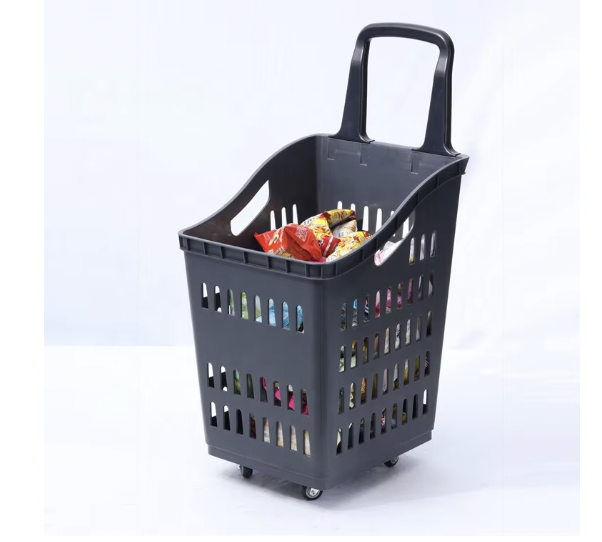חיוני עגלה לקניות פתרונות לסביבות קמעונאות מודרניות
הפשוט סל הסופרמרקט משמשת כאבן הפינה של כל פעולה מסחרית מוצלחת, ומשפיעה ישירות על חוויית הקונה וכישורי הקנייה. מהרגע שהלקוחות נכנסים לחנות ועד למסע האחרון שלהם דרך תהליך התשלום, כלים חיוניים אלו ממלאים תפקיד מרכזי בקביעת רמת הסיפוק ונפח הרכישות.
למרבץ הקמעונאי של ימינו יש צורך בחשיבה רצינית בבחירת פתרון הסל המתאים. עם ההתפתחות של ההתנהגות הצרכנית וההתמקדות הגוברת בקיימות, הבחירה בסלי קניות יכולה להשפיע משמעותית הן על הצלחת המבצע והן על נאמנות הלקוח.
שקולות חומרים לפתרונות קנייה עמידים
בניה מפלסטיק מול מתכת
אפשרויות סל קניות מודרניות במרכולים כוללות לרוב סלים עשויים מפלסטיק או ממתכת, וכל אחת מהן מציעה יתרונות ייחודיים. סלים מפלסטיק איכותי מספקים קלות ועמידות, תוך הפחתת רמות הרעש בעת השימוש. משטחיהם החלקים מונעים מפגיעה במוצרים ומאפשרים ניקוי קל. סלים ממתכת, למרות שמשקלם כבד יותר, מצטיינים בבריאות גבוהה במיוחד ויכולים לעמוד בשימוש יומיומי כבד מבלי להראות סימני בלאי.
בעת הערכת אפשרויות של פלסטיק, חפשו חומרים בעלי התנגדות ל-UV המונעים הזנחה ופירוק באור חזק של תאורה בחנות. תבניות פלסטיק מתקדמות גם הן עמידות בפני סדקים ושומרות על צורתן גם תחת עומסי עבודה כבדים. עבור חלופות מתכת, סופות מפוצן משופרות מגינות מפני קורוזיה ומספקות מראה מושך שנותר ללא שינוי לאורך שנים של שירות.
השפעה סביבתית וקיימות
צרכנים מודעים לסביבה מעריכים את המוכרים שמפגינים מחויבות ליציבות. יצרנים רבים מציעים כיום סלי קניות שעשויים מחלקים מזוהרים או תהליכי ייצור ידידותיים לסביבה. הבחירות היציבות הללו מושכות לא רק צרכנים ירוקים, אלא לרוב מציעות יתרונות כלכליים בזכות קיימות גבוהה וحوות מיסוי פוטנציאליות.
שקול סלים שעשויים מפלסטיק מזוהר לאחר צריכה או סלים שזוהו על ידי ארגונים סביבתיים. כמה עיצובים חדשניים כוללים אפילו חומרים מתפרקים ביולוגית מבלי לפגוע באיכות המבנית. התחשבות זו בסביבה יכולה להפוך לנקודת שיווק חשובה, ולתת תרומה ליעדי היציבות של הארגון.

מאפייני עיצוב המשפרים את חוויית הקנייה
היקשים ארגונומיים
עיצובים האפקטיביים ביותר של סלי קניות בסופרמרקט ממקדים נוחות למשתמש באמצעות תכונות ארגונומיות. עיצובי המנשא צריכים לחלק את המשקל באופן שווה תוך כדי שמייצרים אפשרויות אחיזה נוחות עבור גדלים שונים של כפות ידיים. העומק והרוחב של הסל חייבים לאזן בין נפח האחסון לבין הניידות, כדי להבטיח ללקוחות אפשרות להועתק בקלות את הבחירות שלהם ברחבי החנות.
תכונות ארגונומיות מתקדמות עשויות לכלול אפשרויות של שני מנשאים, משטחי אחיזה מפופים או מערכות חדשניות לחלוקת משקל. אלמנטים אלו הופכים להיות חשובים במיוחד לקונים מבוגרים או לאנשים עם מגבלות פיזיות, ומביאים לידי ביטוי את נגישות החנות שלך לכלל קהל הלקוחות.
יכולות איחסון והטיה
פתרונות איחסון יעילים הם אס Rimuyim להנהלת מלאי סלים בסופרמרקט בין השימושים של הלקוחות. דגמים מודרניים מציעים בדרך כלל יכולת היטמן, המאפשרת סידור מרובים של סלים זה בתוך זה כאשר הם אינם בשימוש. תכונה זו ממקסמת את שטח הרצפה הזמין, תוך שמירה על תחנות סלים מסודרות לאורך החנות.
יש לשקול מערכות המשלבות מנגנוני היטמן חלקים כדי למנוע חסימות ולמזער את הבלייה במהלך ההטמה. כמה דגמים מתקדמים כוללים אף מחיצות מובנות או מסילות היטמן מיוחדות המגינות על פני השטח של הסלים במהלך האיחסון, תוך וודאות על גישה מהירה ללקוחות הנכנסים.
אופטימיזציה של נפח וגודל
דרישות נפח
קביעת הקיבולת האופטימלית של סלי קניות בסופרמרקט מחייבת ניתוח זהיר של גודל העסקה הרגילה ותכולת המוצרים. הסלים הסטנדרטיים צריכים להכיל את נפח הקנייה הממוצע, תוך שמירה על נוחות שימוש מרבית לרוב הלקוחות. לרשתות רבות יש יתרון בהצעת אפשרויות שונות בגודל הסלים כדי לשרת מטרות קנייה שונות, החל מקניות מהירות ועד קניות מפורטות ותוכנן מראש.
קחו בחשבון את נפח הסלים בהתאם לתכנון חנותכם ואסטרטגיית המרמקטינג. אפשרויות בנפח גדול עובדות טוב בחנויות עם הצעות מנות גדולות או תצוגות שיווקיות, בעוד שהקטנות יותר מתאימות למיקומים עירוניים או מדרכות תחנות תשלום מהירות.
יעילות שטח ויכולת תמרון
עיצובים האפקטיביים ביותר של סלי קניות בסופרמרקט משלבים בין נפח הקנייה לבין היכולת לנוע בחנויות בצורה חלקה. קחו בחשבון את תכנון החנות שלכם, כולל רוחב מדרכות ומבנה התצוגות, בבחירת ממדי הסלים. עיצובים אופטימליים מאפשרים ללקוחות לנוע בחנויות בקלות תוך מקסום נפח הקנייה.
הקפידו על רוחב הסל ביחס לרווח בין המרצפות ולעיצוב דלפק התשלום. דגמים חדשניים מציגים עיצוב בצורת חרוט שמשפר את הנוחות בהובלה מבלי להקריב קיבולת, ומבטיח זרימה חלקה של הקונים לאורך כל חוויית הקנייה.
היקף השמירה והאריכות חיים
פרוטוקולי ניקיון וסניטציה
סביבות קמעונאות מודרניות דורשות פתרונות ניקיון עמידים לסלים על מנת לשמור על רמות ההיגיינה. בחרו חומרים ועיצובים שמאפשרים תהליכי ניקיון יעילים תוך כדי עמידות בסניטציה תכופה. משטחים חלקים ללא חריצים עמוקים או פינות חדות תורמים לניקיון מעמיק ומקלים על תהליך זה.
שקלו ליישום מערכות ניקיון אוטומטיות או ציוד סניטציה מותאם לשימוש עם עיצוב הסלים שבחרתם. יצרנים מסוימים מציעים טיפול אנטי-מיקרוביאלי או ציפויים מיוחדים שמשפרים את רמת ההיגיינה בין מחזורי ניקיון רגילים.
עומס ותכנון החלפה
ניהול עלויות לטווח ארוך מחייב שיקול דעת לגבי עמידות הסלים ומחזור ההחלפה שלהם. סלים איכותיים של סופרמרקט צריכים לספק מספר שנים של שירות בתנאי שימוש רגילים. הקם מערכות פיקוח למעקב אחר מצב הסלים ותוכנית החלפות לפני שגרעון במצבם ישפיע על חוויית הלקוח.
קח בחשבון את תנאי האחריה ותמיכה מצד היצרן בבחירת ספקים לסלים. חלק מהספקים מציעים תוכניות תחזוקה או אחריות להחלפה שיכולים לעזור בפחת עלויות לטווח ארוך תוך וודאות של שימור איכות סלים עקבית.
שאלות נפוצות
כמה סלים של סופרמרקט על כל רגל מרובע צריכה חנות לשמור?
תקן התעשייה ממליץ לשמור כביכול סל אחד על כל 50-75 רגל מרובע של שטח קמעונאי, כשהיחס מותאם לתקופות קנייה שיא וنمטי תנועה של לקוחות. היחס הזה מבטיח זמינות מספקת תוך אופטימיזציה של דרישות האיחסון.
אילו חומרים הם העמידים ביותר עבור סלים של סופרמרקט?
פוליאתילן בצפיפות גבוהה (HDPE) ונירוסטה מצפים כרומיום מייצגים את האפשרויות החזקות ביותר של חומרים. פוליאתילן בצפיפות גבוהה מציע עמידות מمتازה בפני השפעות ותחזוקה קלה, בעוד נירוסטה מצפים כרומיום מספק יכולת נשיאה וחיים אורך גבוהים יותר.
מתי יש להחליף סלים של מכולת?
סלים איכותיים של מכולת נמשכים בדרך כלל 3-5 שנים בתנאי שימוש רגילים. עם זאת, זמני ההחלפה תלויים בעוצמה של השימוש, בתactices התחזוקה ובmarkers של בלאי. בדיקות קבועות עוזרות לקבוע את זמני ההחלפה האופטימליים.
אילו תכונות יש להעדיף עבור לקוחות זקנים?
בעבודה עם לקוחות זקנים, יש להעדיף חומרים קלים, ידיות ארגונומיות עם אזור אחיזה מספק, ועיצובים יציבים שمقاימים את ההטיה. תכונות נוספות עשויות לכלול פתחי ידיות רחבים יותר ויכולת תנועה חלקה לאפשרות המעבר מהסל לعربה.

